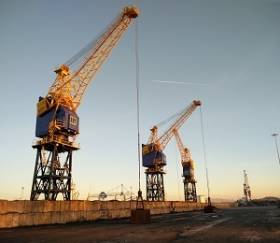Displaying items by tag: Cranes Refurb Investment
#Cranes&Cruises – Two ports in south Wales operated by Associated British Ports (ABP) have invested over £2.8 million in the refurbishment of five cranes at Newport and Swansea, writes Jehan Ashmore.
The work which took 14 months to improve operational efficiency and extend the lifespan of the cranes was carried out by Port Talbot based engineering company, Celtic Engineering. Among the products to be handled by the cranes are coal, aggregates, forest products and steel. The refurbishment also allowed for increased handling efficiency when loading and discharging vessels.
Afloat.ie has also been researching UK operator Cruise & Maritime Voyages (CMV) whose 1,250 passenger capacity flagship Magellan is to offer a direct departure from Newport located to the east of Cardiff. Cruise-goers in season 2017 can take a two-night Dublin Mini-Cruise in June or remain on the 46,000 gross tonnage vessel as part of a longer 11 nights Fjordland Splendour & Dublin Cruise. More on Magellan but that of CMV's move to offer direct cruises from the Irish capital will appear on our Cruise Liners news.
Further along the coast beyond the Walsh capital to the west is Swansea where the investment programme by ABP to upgrade cranes will be complemented by a new Mantsinen Hydraulic Crane due to be installed at the port next month. The crane forms part of a £6 million deal that will see five new cranes delivered across the UK port group’s network of 21 ports.
Swansea has strong Irish maritime connections given the former Swansea-Cork Ferries service that was followed by last incumbent, Fastnet Line that ceased operations in 2011. In more recent times at Swansea Dry Docks the shiprepairer and recycling facility was last winter the recipient of Cork based Mainport Group’s disposed seismic support vessel Mainport Ash.





























































